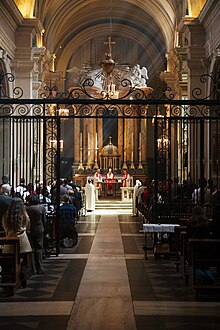Santissima Trinità dei Monti
| Santissima Trinità dei Monti | |
|---|---|
| Denomination : | Roman Catholic |
| Patronage : | Trinity |
| Consecration year : | 1585 |
| Order : | Community of Emmanuel |
| Cardinal priest : | Philippe Barbarin |
| Parish : | Sant'Andrea delle Fratte |
| Address: | Piazza Trinità dei Monti, 3 00187 Roma |
Coordinates: 41 ° 54 ′ 22.6 ″ N , 12 ° 29 ′ 1.2 ″ E The Church of Santissima Trinità dei Monti , also Santa Trinità dei Monti or Santissima Trinità al Monte Pincio ( Latin: Sanctissimae Trinitatis in Monte Pincio , “Most Holy Trinity am Berge Pincio ”), is located above the Spanish Steps in Rome . The Obelisco Sallustiano stands in front of the church.
history
The order to build the church was given by King Ludwig XII , who was then in Italy . of France in 1482. In 1495 construction began. The church was completed in 1587 as part of a Paulan monastery that had existed since 1494 ; the consecration was carried out by Pope Sixtus V.
In the meantime, the church has been profaned and served, among other things, as a studio for the artist Jean-Auguste-Dominique Ingres .
Since the church and the adjoining monastery had become very dilapidated at the beginning of the 19th century, Louis XVIII. from France in 1816 a major restoration.
Today the monastery belongs to the Society of the Sacred Heart of Jesus ; in the summer of 2006 the church was given to the communities of Jerusalem for use. It is the titular church of Cardinal Philippe Barbarin .
description
Due to its location above the Spanish Steps, the church is a popular postcard and photo opportunity. Particularly striking is the western double tower facade in the Renaissance style , which may have been designed by Giacomo della Porta . The interior of the one- nave church is also influenced by the Renaissance, but Gothic forms are also present, especially in the choir room.
The nave is divided into several bays by pilasters , which are connected to chapels on both sides. In the east, the nave transitions through a pointed triumphal arch into the choir, which has a straight end.
Furnishing
Inside the church there are several frescoes that were created by Perino del Vaga , among others .
One of the chapels on the north side houses an altarpiece of Maria Immaculata , which was created by Philipp Veit .
A few other paintings in the church are by Daniele da Volterra, a student of Michelangelo . A descent from the cross from 1541 is particularly noteworthy.
The high altar of the church is crowned by six Corinthian columns , which are grouped around the dome-like tabernacle structure . Above the pillars there is a glory, in the center of which the eye of providence is represented.
Camera papagallo
In the monastery adjoining the church there is a fantastically painted cell , which was called Camera papagallo ("parrot room "):
“In the monastery of Trinitá dei Monti, the monks Le Sueur and Jacquier had Charles L. Clérisseau put up frescoes in their cell, thanks to which they could escape the strict monastic seclusion and imagine themselves in the world of classical antiquity, which they read and in conjured up by the imagination. The French artist, student and disciple of Natoire has succeeded in creating a visual transition between the cell ceiling and the walls, so that the narrow space is transformed into the picturesque ruin of a pagan temple. The monastery cell became a place of pilgrimage for art lovers and cultivated Romans. "
Burials
- 1682: Claude Lorrain , French landscape painter
- 1689: Charles Errard (the Younger) (* before 1607) French painter, engraver and Baroque architect, co-founder of the Académie royale de peinture et de sculpture (1648) and the Académie de France à Rome (1666)
See also
literature
- Christoph Höcker: Rome . In: Reclam's city guide . 2nd Edition. Reclam, Stuttgart 2012, ISBN 978-3-15-018980-1 , pp. 118-119 .
- Herbert Rosendorfer: Church leader Rome . 5th edition. EA Seemann, Leipzig 2013, ISBN 978-3-86502-261-5 , p. 249-251 .
Web links
Individual evidence
- ^ Diocese of Rome
- ↑ Miriam Milman: Das Trompe-L'oeil - Painted architecture . 1982, ISBN 3-8030-3106-0 .

